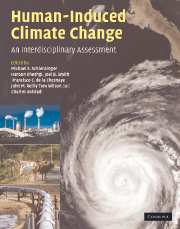Book contents
- Frontmatter
- Contents
- List of contributors
- Preface
- Part I Climate system science
- Part II Impacts and adaptation
- Part III Mitigation of greenhouse gases
- 15 Bottom-up modeling of energy and greenhouse gas emissions: approaches, results, and challenges to inclusion of end-use technologies
- 16 Technology in an integrated assessment model: the potential regional deployment of carbon capture and storage in the context of global CO2 stabilization
- 17 Hydrogen for light-duty vehicles: opportunities and barriers in the United States
- 18 The role of expectations in modeling costs of climate change policies
- 19 A sensitivity analysis of forest carbon sequestration
- 20 Insights from EMF-associated agricultural and forestry greenhouse gas mitigation studies
- 21 Global agricultural land-use data for integrated assessment modeling
- 22 Past, present, and future of non-CO2 gas mitigation analysis
- 23 How (and why) do climate policy costs differ among countries?
- 24 Lessons for mitigation from the foundations of monetary policy in the United States
- Part IV Policy design and decisionmaking under uncertainty
- Index
- Plate section
- References
18 - The role of expectations in modeling costs of climate change policies
from Part III - Mitigation of greenhouse gases
Published online by Cambridge University Press: 06 December 2010
- Frontmatter
- Contents
- List of contributors
- Preface
- Part I Climate system science
- Part II Impacts and adaptation
- Part III Mitigation of greenhouse gases
- 15 Bottom-up modeling of energy and greenhouse gas emissions: approaches, results, and challenges to inclusion of end-use technologies
- 16 Technology in an integrated assessment model: the potential regional deployment of carbon capture and storage in the context of global CO2 stabilization
- 17 Hydrogen for light-duty vehicles: opportunities and barriers in the United States
- 18 The role of expectations in modeling costs of climate change policies
- 19 A sensitivity analysis of forest carbon sequestration
- 20 Insights from EMF-associated agricultural and forestry greenhouse gas mitigation studies
- 21 Global agricultural land-use data for integrated assessment modeling
- 22 Past, present, and future of non-CO2 gas mitigation analysis
- 23 How (and why) do climate policy costs differ among countries?
- 24 Lessons for mitigation from the foundations of monetary policy in the United States
- Part IV Policy design and decisionmaking under uncertainty
- Index
- Plate section
- References
Summary
Introduction
Policies to address climate change in the European Union and the United States, as well as international negotiations under the UN Framework Convention on Climate Change, have come to share a surprising feature. All define carbon limits over only a very short time-frame compared with either the timescales characteristic of climate processes or the time horizon over which investments in mitigation measures must be evaluated. The Kyoto Protocol set national greenhouse gas emission targets only through 2012, and did not allow negotiations on targets for the Second Commitment period from 2013 to 2017 to begin until the protocol enters into force. In the European Union, a pilot emission trading system has been set up for the years 2005–2007, but targets and allocations for the First Commitment period limits were not specified. In the United States, proposed legislation to limit US greenhouse gas emissions has been specific about limits to 2020 but purposely ambiguous about limits further in the future.
The short time horizons arise at least in part from the fundamental impossibility of binding future governments (through legislation or treaty) to policies that must be implemented and enforced over the indefinite future. Short policy horizons pose very difficult problems for assessing costs because silence on long-term limits leaves considerable ambiguity over long-term expectations about policies not yet enacted.
- Type
- Chapter
- Information
- Human-Induced Climate ChangeAn Interdisciplinary Assessment, pp. 216 - 226Publisher: Cambridge University PressPrint publication year: 2007
References
- 1
- Cited by



